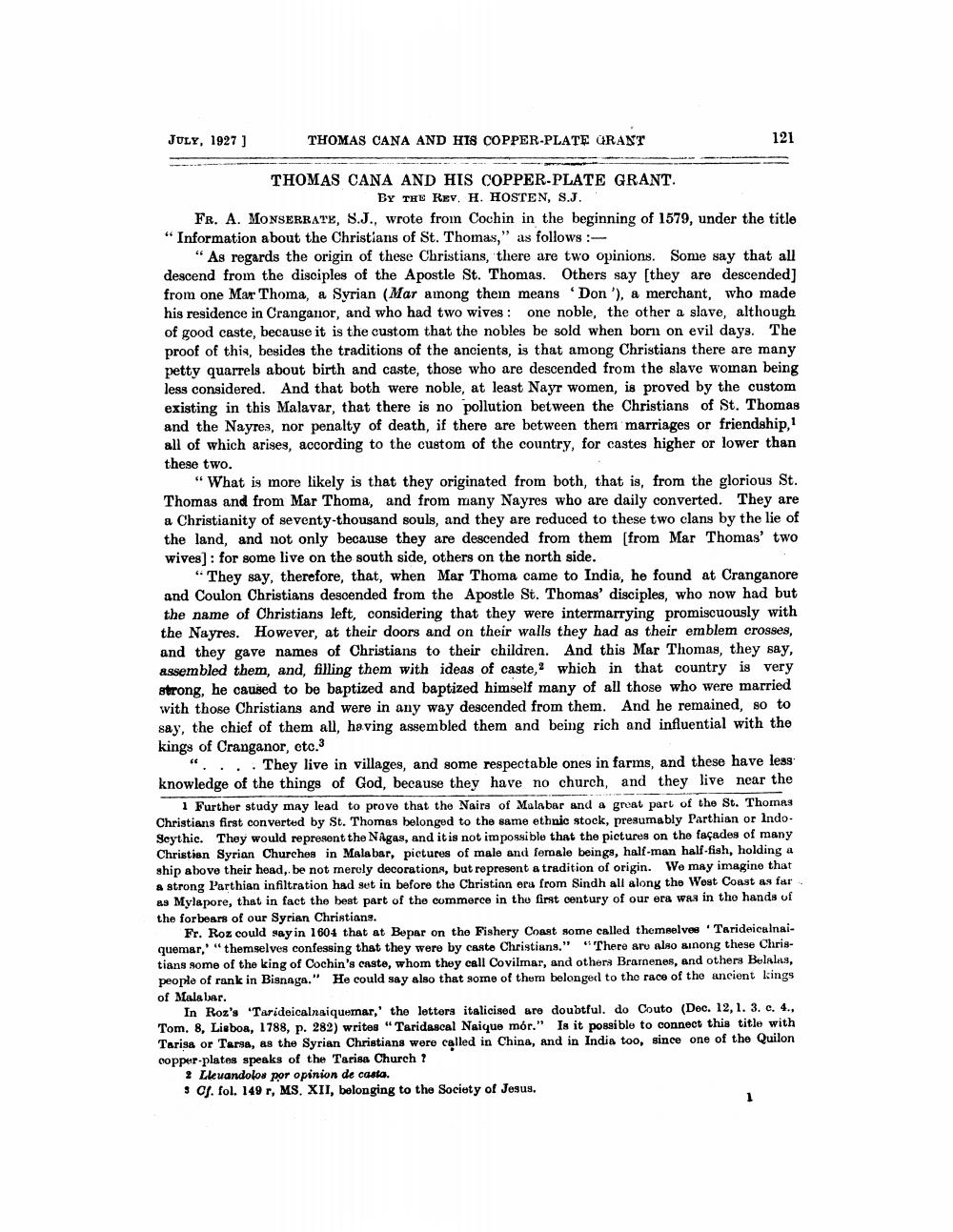________________
JULY, 1927 ]
THOMAS CANA AND HIS COPPER-PLATE GRANT
121
THOMAS CANA AND HIS COPPER-PLATE GRANT.
BY THE REY, H. HOSTEN, S.J. FR. A. MONSERRATY, S.J., wrote from Cochin in the beginning of 1579, under the title "Information about the Christians of St. Thomas," as follows:
"As regards the origin of these Christians, there are two opinions. Some say that all descend from the disciples of the Apostle St. Thomas. Others say (they are descended) from one Mar Thoma, a Syrian (Mar among them means 'Don'), a merchant, who made his residence in Cranganor, and who had two wives: one noble, the other a slave, although of good caste, because it is the custom that the nobles be sold when born on evil days. The proof of this, besides the traditions of the ancients, is that among Christians there are many petty quarrels about birth and caste, those who are descended from the slave woman being less considered. And that both were noble, at least Nayr women, is proved by the custom existing in this Malavar, that there is no pollution between the Christians of St. Thomas and the Nayrez, nor penalty of death, if there are between them marriages or friendship, all of which arises, according to the custom of the country, for castes higher or lower than these two.
"What is more likely is that they originated from both, that is, from the glorious St. Thomas and from Mar Thoma, and from many Nayres who are daily converted. They are a Christianity of seventy-thousand souls, and they are reduced to these two clans by the lie of the land, and not only because they are descended from them (from Mar Thomas' two wives] : for some live on the south side, others on the north side.
"They say, therefore, that, when Mar Thoma came to India, he found at Cranganore and Coulon Christians descended from the Apostle St. Thomas' disciples, who now had but the name of Christians left, considering that they were intermarrying promiscuously with the Nayres. However, at their doors and on their walls they had as their emblem crosses, and they gave names of Christians to their children. And this Mar Thomas, they say, assembled them, and, filling them with ideas of caste, which in that country is very strong, he caused to be baptized and baptized himself many of all those who were married with those Christians and were in any way descended from them. And he remained, so to say, the chief of them all, having assembled them and being rich and influential with the kings of Cranganor, etc.3
".... They live in villages, and some respectable ones in farms, and these have less knowledge of the things of God, because they have no church, and they live near the
1 Further study may lead to prove that the Nairs of Malabar and a groat part of the St. Thomas Christians first converted by St. Thomas belonged to the same ethnic stock, presumably Parthian or Indo. Seythic. They would represent the NAgas, and it is not impossible that the pictures on the façades of many Christian Syrian Churches in Malabar, pictures of male and female beings, half-man half.fish, holding a ship above their head, be not merely decorations, but represent a tradition of origin. We may imagine that a strong Parthian infiltration had set in before the Christian era from Sindh all along the West Coast as far as Mylapore, that in fact the best part of the commerce in the first century of our era was in the hands of the forbears of our Syrian Christians.
Fr. Roz could say in 1604 that at Bepar on the Fishery Coast some called themselvee 'TarideicaInaiquemar," themselves confessing that they were by casto Christians." "There aru alao sinong these Christians some of the king of Cochin's caste, whom they call Covilmar, and others Brarnenes, and others Belalus, people of rank in Bisnaga." He could say also that some of them belonged to the race of the ancient kings of Malabar.
In Roz's 'Tarideicalnaiquemar,' the letters italicised are doubtful. do Couto (Dec. 12, 1. 3. c. 4., Tom. 8, Lisboa, 1788, p. 282) writes "Taridascal Naique mór." Is it possible to connect this title with Tarisa or Tarsa, as the Syrian Christians were called in China, and in India too, since one of the Quilon copper-plates speaks of the Tarisa Church ?
2 Lleuandolos por opinion de casta. 3 of. fol. 149 r, MS. XII, belonging to the Society of Jesus,




